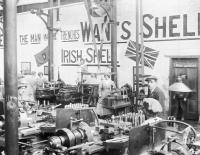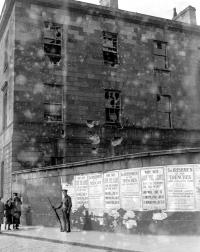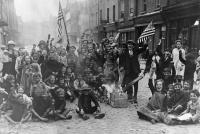Oh what a lovely war! Dublin and the First World War
Published in 20th Century Social Perspectives, 20th-century / Contemporary History, Features, Issue 6 (Nov/Dec 2011), Volume 19, World War I
‘THE MAN IN THE TRENCHES WANTS SHELLS—IRISH SHELL’ says the slogan on the wall at the National Shell Factory in Dublin. Work in the munitions factories at Parkgate and in the Dublin Dockyard Company saw working-class women earning more than many of their male counterparts. While the war was a liberating experience for women of all social classes, only those from working-class backgrounds were subjected to regular social censure, usually for spending leisure time in pubs and ‘the low saloon’ of O’Connell Street. (Imperial War Museum)
The First World War was good for Dublin. Living standards rose and mortality rates fell as money flowed into the tenements in separation payments to soldiers’ wives. The British government’s relatively generous compensation to property owners for the destruction wrought in 1916 allowed for a slight reduction in the commercial rates, and Lloyd George provided well-paid jobs for working-class women in the munitions industry. The British government also established an industrial relations mediation system that ensured de facto union recognition in return for no strikes. Of course there were strikes, but because Dublin’s contribution to the war effort was peripheral offenders never suffered the severe sanctions imposed on militant shop stewards in Britain. Yet the war was never popular. Nor could it be. The pre-war disaster of Bachelors’ Walk, when troops opened fire, killing three civilians outright and wounding over 80 more on 26 July 1914, the day of the Howth gunrunning, overshadowed the outbreak of hostilities in Europe. The funerals, at which one of the chief mourners was a British soldier burying his mother, were a massive demonstration of nationalist discontent at what was seen as the double standards by which the British government dealt with them compared with unionists in the Home Rule crisis. John Redmond’s dramatic pledge of support for the war effort in the House of Commons had little impact in the city. Only one Dublin councillor, nationalist Alderman Dr James McWalter, joined the colours.
Servants of the half-crown
Food and fuel shortages undermined popular support for the war long before 1916. This was aggravated by the crass insensitivity of the military top brass towards the nationalist contribution to the war effort. About 450 people died in the Rising and perhaps 2,500 were injured, although only 450 personal injury claims for deaths or serious injuries were made. By comparison there were 820 claims for damage to property. The war at the front claimed the lives of almost 5,000 Dubliners out of 25,000 who joined the colours and many survivors never returned to Ireland. A similar pattern emerged among the 9,000 workers who took jobs in protected British war industries after 1916. Many migrant workers abandoned their families. The average weekly remittance from those who didn’t was only 10s. In contrast, a soldier’s wife could expect 12s 6d a week, plus at least 2s 6d for each child.Dublin was a major recruiting ground for the British Army long before 1914, but the allegiance of these men was to the half-crown rather than the Crown. The army provided one of the few sources of a steady income for the city’s vast army of underemployed unskilled workers. It also provided the possibility of learning a trade, something which the nepotism of the craft unions denied them. On discharge a soldier could earn a retainer of 7s a week as a reservist. When war came unexpectedly in August 1914, well over 3,000 men were sucked out of the city, inadvertently creating jobs for workers blacklisted in the 1913 Lockout. What genuine volunteering there was came from the unionist community and from those members of the Catholic middle classes inspired by Redmond’s call to fight for small nations abroad and his vision of Irishmen being united by a blood sacrifice at the front. There was plenty of blood shed, especially at Gallipoli, which was to Dublin what the Somme was to Belfast. Any hope of continued support for the war died with the leaking of despatches by senior officers disparaging the performance of Irish troops, blaming them for the débâcle at the Dardanelles.The appeal of the Volunteers was not simply that weekend soldiering was safer and pleasanter than service in the British Army but also that it provided a social and educational forum for members. Its attractiveness increased as war casualties mounted. Nationalists who had a choice opted for the Volunteers. It was nationalists who lacked such a choice—the unemployed—who continued to join the colours. Working-class Dubliners took advantage of Britain’s manpower shortages to opt for service in technical arms, including the Royal Flying Corps and its successor, the Royal Air Force—thus upskilling out of harm’s way.

A soldier guards British Army recruiting posters on a wall of the battered Four Courts in the wake of the Rising. (TopFoto)
Of cowkeepers, unionists and women war workers
Fuel shortages were so severe that Dublin had only a month’s coal supply left at the end of 1918. Cutbacks in power generation led to early closing for shops and businesses. Profiteering was rife and attempts at price controls largely ineffective. The regular appearance of milk suppliers in the courts for adulterating produce and attempting to increase prices made the Cowkeepers’ Association one of the most hated bodies in the city. The British government almost taxed the city’s breweries and distilleries out of existence. It was perhaps fitting that the last great rally of the Irish Party was in the Phoenix Park in 1915, in defence of the drinks industry, given its dependence on publicans in the city. The unionist community, over 90,000 strong in Dublin city and county, remained loyal to the Crown, and this had the unintended consequence of colonising voluntary bodies associated with the war effort as nationalists withdrew. For instance, the Royal Dublin Fusiliers Prisoners of War Association was run from the premises of the Dublin Women’s Unionist Club. Women in the unionist community also contributed disproportionately to the Voluntary Aid Detachments in areas such as nursing. An unexpected dividend was the rapid emergence of auxiliary hospitals during the Rising. The hospital supply depot at 50 Merrion Square carried out its first amputation by 5pm on Easter Monday within the sound of gunfire. No middle-class women of any political persuasion worked in the city’s munitions factories, unlike in Britain, where the war tended to break down social barriers. In Dublin, middle-class women preferred unpaid voluntary work to the stigma of a factory job, except in a professional capacity. Hanna Sheehy Skeffington’s sister, Margaret Culhane, only became a welfare superintendent at the National Shell Factory after the sudden death of her husband Frank made her the family breadwinner.

Children celebrating the end of the war with the Stars and Stripes, the acceptable face of Allied victory. America was the receptacle of hope for international recognition at the Peace Conference. (Bettmann/Corbis)
Don’t mention the war!
Dublin Corporation was almost unique among local authorities in not condemning the Rising. But then it was certainly unique in having both members and employees heavily involved. Votes of sympathy were regularly passed without reference to the circumstances of the bereavements. Such a vote for Sir Thomas Esmonde on the death of his teenage son ‘through the destruction of His Majesty’s ship Invincible’ was the nearest the Corporation ever came to mentioning military operations.While the families of those executed after the Rising were well looked after and benefited from the subsequent upsurge in support for advanced nationalism, ordinary civilians were thrown on the meagre charity of Dublin Castle. Just over 60 out of 450 claims were conceded by the Dublin Victims’ Committee and virtually all were severely cut by the assistant secretary for Ireland, John Taylor. Some families received as little as £25 to £5 for serious injuries or loss of life. Many workers lost their jobs because companies closed or because, as in the case of the Great Southern and Western Railway Company, employees could not satisfactorily explain their failure to report for work during the Rising. Hostility to the war was always more marked than elsewhere in Ireland. After the Rising, soldiers were verbally abused and even assaulted on the street. People cheered ‘the torpedo that sank Kitchener’ in June 1916. (It was actually a mine that sank his ship.) Prostitution was conveniently put down to the existence of the British garrison, and respectable middle-class Protestants were as outraged as their Catholic counterparts that lewd music hall reviews and films could not be banned because the War Office promoted them to entertain the troops. Nor did the city receive help tackling its most pressing problem, slum clearance. During the war nearly 1,000 tenements were closed as unsafe but only 327 new homes were built when 50,000 people urgently needed rehousing.With municipal elections suspended for the duration of the war, politics took to the streets. The funeral of Thomas Ashe, who died on hunger strike in 1917, was the greatest demonstration of separatist strength during the war. Among the principal mourners was Dr William Walsh, archbishop of Dublin, who played a key role in distancing the Catholic hierarchy from the Irish Parliamentary Party (IPP). William Martin Murphy, owner of the Independent Group of newspapers, facilitated the rise of Sinn Féin by constant sniping at the IPP leadership.
Connolly—more useful dead than alive
The Labour Movement in Dublin, particularly the Irish Transport and General Workers Union, staged a remarkable recovery after the Rising. James Connolly’s period as acting general secretary had been a disaster. Membership plummeted and he became so preoccupied with the Irish Citizen Army that the union executive was on the verge of sacking him when the Rising occurred. He proved more valuable to the Labour Movement dead, when the rich intellectual reservoir of his writings provided a critique for socialists and trade unionists to attack not only capitalism and British imperialism but also each other! Connolly’s political heirs were few even in Dublin, and the wider labour movement was largely apolitical. Thus it played a central role in the greatest victory Irish nationalism ever achieved over British imperialism, and a bloodless one at that—the anti-conscription campaign—without ever collecting the political kudos. This went to Sinn Féin and the Catholic hierarchy. In 1918 Dublin’s 90,000 unionists were still firmly attached to the Union but were even more concerned at the prospect of partition. They made a strong showing in the general election and Sir Maurice Dockrell won the only Unionist seat outside of Ulster and the Trinity College constituency, in Rathmines. But there was no denying the changes in the city. Sidelined for a century, Dublin assumed a central role in national events during the war. HI
Padraig Yeates is a freelance journalist and writer.
Further reading:
J. Horne (ed.), Our war: Ireland and the Great War (Dublin, 2008).J.V. O’Brien, Dear dirty Dublin: a city in distress 1899–1916 (Berkeley, 1982).C. Wills, Dublin 1916: the siege of the GPO (London, 2009).P. Yeates, A city in wartime: Dublin 1914–1918 (Dublin, 2011).
















